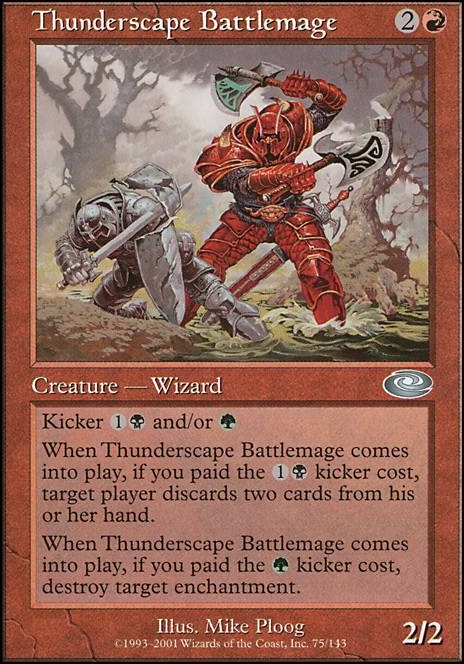Big boiz (16)
- 1x Experiment One
- 1x Nested Shambler
- 1x Gluttonous Slug
- 1x Horned Kavu
- 1x Elephant Guide
- 1x Jewel Thief
- 1x Chain Devil
- 1x Crimson Fleet Commodore
- 1x Wickerbough Elder
- 1x Avenging Hunter
- 1x Gray Merchant of Asphodel
- 1x Owlbear
- 1x Underdark Explorer
- 1x Generous Ent
- 1x Oliphaunt
- 1x Troll of Khazad-dum
Increment (10)
- 1x Experiment One
- 1x Sadistic Glee
- 1x Creeping Bloodsucker
- 1x Eternal Thirst
- 1x Gluttonous Slug
- 1x Crawling Infestation
- 1x Stirring Bard
- 1x Vicious Battlerager
- 1x Avenging Hunter
- 1x Underdark Explorer
Recycle (6)
- 1x Mortuary Mire
- 1x Urborg Repossession
- 1x Unseal the Necropolis
- 1x Ardent Elementalist
- 1x Dread Return
- 1x Living Lightning
Land (20)
Filter (2)
Hard answers (2)
Tutor (2)
Land tapped (13)
- 1x Black Dragon Gate
- 1x Bojuka Bog
- 1x Darkmoss Bridge
- 1x Drossforge Bridge
- 1x Golgari Rot Farm
- 1x Highland Forest
- 1x Manor Gate
- 1x Mortuary Mire
- 1x Rakdos Carnarium
- 1x Slagwoods Bridge
- 1x Thriving Grove
- 1x Thriving Moor
- 1x Woodland Chasm
Removal (11)
- 1x Lightning Bolt
- 1x Pick Your Poison
- 1x Cleansing Wildfire
- 1x Extract a Confession
- 1x Return to Nature
- 1x Terminate
- 1x Parasitic Impetus
- 1x Shiny Impetus
- 1x Chain Devil
- 1x Snuff Out
- 1x Wickerbough Elder
Fixing (6)
- 1x Abundant Growth
- 1x Cleansing Wildfire
- 1x Jewel Thief
- 1x Generous Ent
- 1x Oliphaunt
- 1x Troll of Khazad-dum
Sustain (5)
- 1x Creeping Bloodsucker
- 1x Eternal Thirst
- 1x Unexpected Fangs
- 1x Parasitic Impetus
- 1x Gray Merchant of Asphodel
Trix (4)
Haste (1)
Commander (1)
Mana (12)
- 1x Arbor Elf
- 1x Springleaf Drum
- 1x Utopia Sprawl
- 1x Wild Growth
- 1x Fertile Ground
- 1x Goblin Anarchomancer
- 1x Sakura-Tribe Elder
- 1x Thunderscape Familiar
- 1x Cultivate
- 1x Kodama's Reach
- 1x Llanowar Visionary
- 1x Overgrowth
Draw (7)
- 1x Night's Whisper
- 1x Snake Umbra
- 1x Unseal the Necropolis
- 1x Yavimaya Elder
- 1x Crimson Fleet Commodore
- 1x Syphon Mind
- 1x Thorn of the Black Rose
Buff (5)
Sweep (4)
Sideboard
Big boiz (13)
- 1x Young Wolf
- 1x Penumbra Spider
- 1x Sarulf's Packmate
- 1x Trumpeting Herd
- 1x Conclave Naturalists
- 1x Entourage of Trest
- 1x Panicked Altisaur
- 1x Sporemound
- 1x Staunch Throneguard
- 1x Rapacious One
- 1x Topiary Panther
- 1x Annoyed Altisaur
- 1x Ulamog's Crusher
Filter (3)
Fixing (1)
Haste (1)
Recycle (1)
Removal (9)
- 1x Nature's Claim
- 1x Abrade
- 1x Cast into the Fire
- 1x Go for the Throat
- 1x Lignify
- 1x Demon's Disciple
- 1x Fleshbag Marauder
- 1x Smashing Success
- 1x Conclave Naturalists
Draw (5)
- 1x Gibbering Barricade
- 1x Bushmeat Poacher
- 1x Entourage of Trest
- 1x Staunch Throneguard
- 1x First-Sphere Gargantua
Buff (2)
Other (1)
Sustain (1)
Land (8)
- 1x Great Furnace
- 1x Haunted Fengraf
- 1x Haunted Mire
- 1x Hickory Woodlot
- 1x Jund Panorama
- 1x Peat Bog
- 1x Tree of Tales
- 1x Vault of Whispers
Mana (7)
- 1x Nature's Lore
- 1x Three Visits
- 1x Firewild Borderpost
- 1x Veinfire Borderpost
- 1x Druid of the Emerald Grove
- 1x Mwonvuli Acid-Moss
- 1x Skyshroud Claim
Increment (2)
Maybeboard
Removal (10)
- 1x Innocent Blood
- 1x Skred
- 1x Tragic Slip
- 1x Cast Down
- 1x Deadly Recluse
- 1x Tithing Blade Flip
- 1x Oubliette
- 1x Stinkweed Imp
- 1x Mold Shambler
- 1x Wrecking Ball
Sustain (4)
Trix (3)
Fixing (1)
Hate (1)
Other (1)
Tutor (1)
Big boiz (8)
- 1x Bayou Groff
- 1x Nest Invader
- 1x Bannerhide Krushok
- 1x Gouged Zealot
- 1x Silumgar Scavenger
- 1x Hooting Mandrills
- 1x Krosan Tusker
Land tapped (5)
Recycle (3)
Filter (2)
Sweep (1)
Increment (8)
- 1x Predatory Hunger
- 1x Basilica Screecher
- 1x Impact Tremors
- 1x Trespasser's Curse
- 1x Witty Roastmaster
- 1x Yuan-Ti Fang-Blade
- 1x Silumgar Scavenger
- 1x Zombie Ogre
Mana (4)
Draw (3)
Buff (2)
Hard answers (1)
Suggestions
Updates Add
Comments
Attention! Complete Comment Tutorial! This annoying message will go away once you do!
Important! Formatting tips — Comment Tutorial — markdown syntax
Please login to comment
98% Casual
Competitive
| Date added | 8 months |
| Last updated | 1 week |
| Legality | This deck is Pauper EDH legal. |
| Cards | 100 |
| Avg. CMC | 2.76 |
| Tokens | Dungeon: Undercity, Eldrazi Spawn 0/1 C, Elephant 3/3 G, Food, Insect 1/1 G, Saproling 1/1 G, Skeleton 4/1 B, Spider 2/4 B, Squirrel 1/1 G, The Initiative, The Monarch, Treasure |
| Folders | PDH |
| Votes | |
| Ignored suggestions | |
| Shared with | |
| Views |

